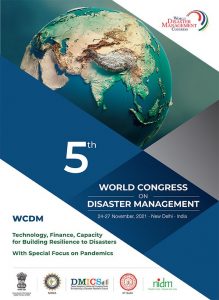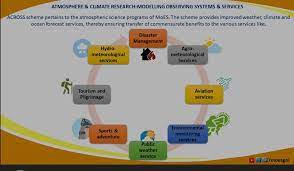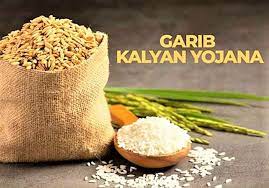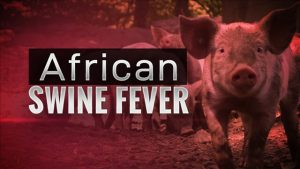Today Current Affairs: 26th November 2021 for UPSC IAS exams, State PSC exams, SSC CGL, State SSC, RRB, Railways, Banking Exam & IBPS, etc
Table of Contents
5th World Congress On Disaster Management:

Raksha Mantri Rajnath Singh virtually inaugurated the 5th World Congress on Disaster Management on November 24, 2021.
- The 5th World Congress on Disaster Management (WCDM) is being organised in New Delhi between November 24-27, 2021 at the campus of IIT Delhi on the overarching theme of ‘Technology, Finance and Capacity for Building Resilience to Disasters in the context of COVID-19’.
- It is an initiative of Disaster Management Initiatives and Convergence Society (DMICS) having its headquarter in Hyderabad to bring researchers, policy makers and practitioners from around the world on the same platform to discuss various challenging issues of disaster risk management.
- The aim is to promote interaction of science, policy and practices to enhance understanding of risks and advance actions for reducing risks and building resilience to disasters.
National Apprenticeship Training Scheme:

Union Cabinet has approved continuation of National Apprenticeship Training Scheme for next five years.
- It has accorded its approval for stipendiary support of Rs. 3,054 crore to apprentices who undergo apprenticeship training under National Apprenticeship Training Scheme (NATS) of Ministry of Education for the period from 2021-22 to 2025-26 (upto 31-03-2026).
- The apprentices who have completed graduate and diploma programme in Engineering, Humanities, Science and Commerce will be given stipend of Rs.9,000/- and Rs.8,000/- per month respectively.
- In keeping with the Government emphasis on “SabkaSaath, SabkaVikas, –SabkaVishwas, SabkaPrayaas”, the scope of NATS has further been expanded to include students from Humanities, Science and Commerce besides students from engineering stream.
- This scheme aims to raise the standards of skill level by strengthening the skill ecosystem and as a result, will provideemployment to approximately 7 lakhs youths in the next five years.
- The NATS will provide apprenticeship in the emerging areas under ‘Production Linked Incentive’ (PLI) such as Mobile manufacturing, Medical devices manufacturing, Pharma sector, Electronics/Technology products, Automobile sector etc.
- The scheme will also be preparingskilled manpowerfor connectivity/logistics industry sectors, identified under GatiShakti.
ACROSS Scheme:

Union Cabinet approved continuation of the umbrella scheme “Atmosphere & Climate Research-Modelling Observing Systems & Services (ACROSS)” along with its eight sub-schemes to the next finance cycle of five years i.e. 2021-2026 at an estimated cost of Rs.2,135 crore.
- The scheme is being implemented by the Ministry of Earth Sciences (MoES) through its units namely India Meteorological Department (IMD), National Centre for Medium Range Weather Forecasting (NCMRWF); Indian Institute of Tropical Meteorology (IITM) and Indian National Centre for Ocean Information Services (INCOIS).
- ACROSS scheme pertains to the atmospheric science programs of Ministry of Earth Sciences (MoES) and addresses different aspects of weather and climate services.
- Each of these aspects is incorporated as eight sub-schemes under the umbrella scheme “ACROSS” and is implemented in an integrated manner through the aforesaid four institutes.
- The eight sub-schemes under the ACROSS scheme are:
- Commissioning of Polarimetric Doppler Weather Radars (DWRs)-IMD
- Upgradation of Forecast System-IMD
- Weather & Climate Services-IMD
- Atmospheric Observations Network-1 MD
- Numerical Modelling of Weather and Climate -NCMRWF
- Monsoon Mission III- IITM/NCMRWF/INCOIS/IMD
- Monsoon Convection, Clouds and Climate Change (MC4)- IITM/NCMRWF/IMD
- High Performance Computing System (HPCS)-IITM/NCMRWF
Pradhan Mantri Garib Kalyan Anna Yojana (PMGKAY-Phase V):

The Union Cabinet has approved the extension for the Pradhan Mantri Garib Kalyan Anna Yojana (PMGKAY-Phase V) for a period of another 4 months i.e. December 2021 till March 2022 @ 5 kg per person per month free of cost for all the beneficiaries covered under the National Food Security Act (NFSA) [Antodaya Anna Yojana & Priority Households] including those covered under Direct Benefit Transfer (DBT).
- In the wake of COVID-19 in the country last year, the Government in March 2020 had announced the distribution of additional free-of-cost foodgrains (Rice/Wheat) to about 80 Crore National Food Security Act (NFSA) beneficiaries at the scale of 5 Kg per person per month under the PM Garib Kalyan Anna Yojana (PM-GKAY), over and above the regular monthly NFSA foodgrains.
- Phase-I and Phase-II of this scheme was operational from April to June, 2020 and July to November, 2020 respectively.
- Phase-III of the scheme was operational from May to June, 2021. Phase-IV of the scheme is currently operational for July-November, 2021 months.
- The PMGKAY scheme for Phase V from December 2021 till March, 2022 would entail an estimated additional food subsidy of Rs. 53344.52 Crore.
- The total outgo in terms of food-grains for PMGKAY Phase V is likely to be about 163 LMT.
What Is Project 75?

Vela, the fourth submarine of P75 of the Indian Navy, will be commissioned on November 25, 2021 by Navy chief Admiral Karambir Singh at the naval dockyard.
- Vela is named after a decommissioned submarine Vela, which served the Navy from 1973 to 2010. The earlier Vela belonged to Foxtrot class submarine of Soviet origin.
- Vela will be commissioned into the Indian Navy’s western command, and will be based in Mumbai.
- This will be the second addition to the Indian Navy’s fleet of warships after INS Vishakapatnam’s commissioning on Sunday.
Project 75:
- Conceptualised for the acquisition for 25 submarines at the time of the IK Gujral government, P 75 evolved into a 30-year plan for building submarines.
- In 2005, India and France signed a $ 3.75 billion contract for building six Scorpene class submarines.
- The executing company on the Indian side is Mazgaon Docks Ltd, and on the French side, it is DCNS, which is now called Naval Group.
Cryptocurrency:
The Cryptocurrency and Regulation of Official Digital Currency Bill, 2021, listed for introduction in Parliament’s Winter Session starting November 29, seeks to “create a facilitative framework for the creation of the official digital currency to be issued by the Reserve Bank of India”.
- The Bill “seeks to prohibit all private cryptocurrencies in India, however, it allows for certain exceptions to promote the underlying technology of cryptocurrency and its uses”.
- There is currently no regulation or ban on cryptocurrencies in India; however, national responses to defining and regulating virtual currencies vary widely in jurisdictions around the world.
- The regulatory and policy response can vary from complete openness of the kind seen in countries like El Salvador, which has approved bitcoin as legal tender, to a total clampdown like in China, which has imposed stringent regulations on both cryptocurrencies and service providers.
- The United States and European Union have been proactive in trying to pin down the regulatory mandate, while discussions continue.
- Countries such as India are somewhere in between — still in the process of figuring out the best way to regulate cryptos after some policy and regulatory experimentation.
Trade Unions Push For Repeal Of Labour Codes:

Over a year since Parliament passed four labour codes (on wages, social security, occupational safety and industrial relations), the Centre is still in the process of notifying the rules to implement the laws and has not set a date for the roll-out.
- Trade unions, however, have planned to intensify their agitation this week against the codes in the wake of the government’s decision to repeal the three farm laws.
Demands by trade unions:
- The two codes we accepted — on wages and social security — be implemented immediately and the two to which we had objections — industrial relations and occupational safety — be reviewed.
About the labour codes:
- The new set of regulations consolidates 44 labour laws under 4 categories of Codes namely, Wage Code; Social Security Code; Occupational Safety, Health & Working Conditions Code; and the Industrial Relations Code.
- The Parliament has already passed all the four Codes and it has also received the President’s assent.
The 4 codes are:
- The Code on Wages, 2019, applying to all the employees in organized as well as unorganized sector, aims to regulate wage and bonus payments in all employments and aims at providing equal remuneration to employees performing work of a similar nature in every industry, trade, business, or manufacture.
- The Code on Occupational Safety, Health and Working Conditions, 2020 seeks to regulate the health and safety conditions of workers in establishments with 10 or more workers, and in all mines and docks.
- The Code on Social Security, 2020 consolidates nine laws related to social security and maternity benefits.
- The Code on Industrial Relations, 2020 seeks to consolidate three labour laws namely, The Industrial Disputes Act, 1947:
- The Trade Unions Act, 1926 and The Industrial Employment (Standing Orders) Act, 1946. The Code aims to improve the business environment in the country largely by reducing the labour compliance burden of industries.
National Family And Health Survey (NFHS)-5:

The National Family and Health Survey (NFHS)-5, the most comprehensive survey on socio-economic and health indicators in the country, has been released.
- The previous four rounds of the NFHS were conducted in 1992-93, 1998-99, 2005-06 and 2015-16.
Highlights of the Report:
- Women outnumber men, fertility has decreased, and India is getting older: There were 1,020 women for 1000 men in the country in 2019-2021.
- This is the highest sex ratio for any NFHS survey as well as since the first modern synchronous census conducted in 1881.
- The Total Fertility Rate (TFR) has also come down below the threshold at which the population is expected to replace itself from one generation to next. TFR was 2 in 2019-2021, just below the replacement fertility rate of 2.1.
- Children’s nutrition improved but at a slower pace: The share of stunted (low height for age), wasted (low weight for height), and underweight (low weight for age) children have all come down since the last NFHS conducted in 2015-16.
- However, the share of severely wasted children has not, nor has the share of overweight (high weight for height) or anaemic children.
- India might be food secure, but nutrition is a problem for adults too: Though India might have achieved food security, 60% of Indians cannot afford nutritious diets.
- NFHS is a large-scale, multi-round survey conducted in a representative sample of households throughout India.
- All NFHSs have been conducted under the stewardship of the Ministry of Health and Family Welfare, Government of India, with the International Institute for Population Sciences (IIPS) Mumbai, serving as the nodal agency.
- NFHS-5 includes some new focal areas, such as death registration, pre-school education, expanded domains of child immunisation, components of micro-nutrients to children, menstrual hygiene, expanded age ranges for measuring hypertension and diabetes among all aged 15 years and above, which will give requisite input for strengthening existing programmes and evolving new strategies for policy intervention.
Digital Service Tax:

India and the US have decided on a “transitional approach” to digital service tax imposed by the government.
- The terms of the deal will be the same that were thrashed out between the US and Austria, France, Italy, Spain, and the UK last week.
- The pact provides relief from the proposed American retaliatory action, while comforting tech giants such as Amazon, Google and Facebook that face the levy.
- The US had announced in January this year that India’s equalisation levy was discriminatory and actionable, and in March, proposed 25 per cent retaliatory tariffs on about 40 products including shrimps, wooden furniture, gold, silver and jewellery items and basmati rice.
- The levies could add up to about $55 million which was the approximate amount of the DST payable by US-based companies such as Google, Amazon, Linkedin and Facebook, as per calculations made by the USTR.
- In a major reform of the international tax system, on October 8 this year, 136 countries, including India, have agreed to an overhaul of global tax norms to ensure that multinationals pay taxes wherever they operate and at a minimum 15% rate.
- However, the deal requires countries to remove all digital services tax and other similar unilateral measures and to commit not to introduce such measures in the future.
African Swine Fever:

African Swine Fever (ASF) is spreading widely in Vietnam and is hurting the local farming industry, forcing the culling of three times the number of hogs culled last year.
- The outbreak has this year spread to 2,275 areas, in 57 out of the country’s 63 cities and provinces, the government said, adding that the authorities have so far this year culled 230,000 hogs.
About African Swine Fever (ASF):
- ASF is a highly contagious and fatal animal disease that infects domestic and wild pigs, typically resulting in an acute form of hemorrhagic fever.
- It was first detected in Africa in the 1920s.
- The mortality is close to 100 per cent, and since the fever has no cure, the only way to stop it spreading is by culling the animals.
- As of now, there is no approved vaccine, which is also a reason why animals are culled to prevent the spread of infection.




